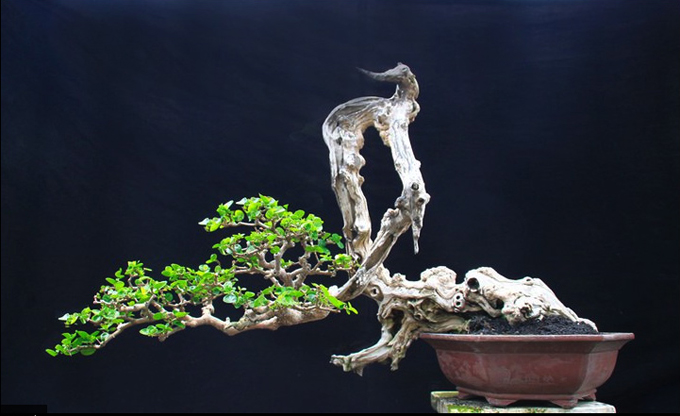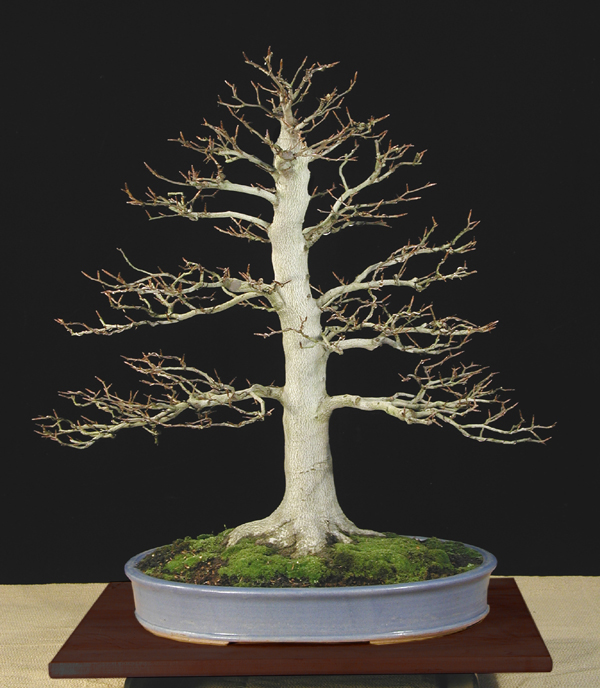 This venerable, naturally dwarfed Ponderosa belongs to American/British bonsai artist and teacher, Colin Lewis. Colin lives on the coast of Maine. Ponderosa pines grow in the inland mountains of the western U.S.; two distinctively different environments.
This venerable, naturally dwarfed Ponderosa belongs to American/British bonsai artist and teacher, Colin Lewis. Colin lives on the coast of Maine. Ponderosa pines grow in the inland mountains of the western U.S.; two distinctively different environments.Climate, native species and culture
If you get a chance, take a look at the comments from the last post. They expand and provide insight into what started as a simple post with a single idea: the effects of culture (human rather than biological culture) on local bonsai styles. The first three comments deal mostly with nature (climate and other growing conditions, and native species) and the forth by Colin Lewis, returns to and amplifies the notion of culture as a primary influence on bonsai styles. Rather than say much more here, I’ll let Colin speak for himself (below). But first a couple more photos.
 A wonderfully gnarly Premna by Robert Steven and his good friend, ‘Mother Nature.’ No way you’ll ever find a tree anything like this in the Green Mountains of Vermont or the scrub pine forests of Maine. It is distinctively tropical and almost looks like it grew in some unearthly magical realm (Indonesia, in fact). Robert is a frequent contributor to this blog and is the author of two distinguished and invaluable bonsai books: Vision of My Soul and Mission of Transformation.
A wonderfully gnarly Premna by Robert Steven and his good friend, ‘Mother Nature.’ No way you’ll ever find a tree anything like this in the Green Mountains of Vermont or the scrub pine forests of Maine. It is distinctively tropical and almost looks like it grew in some unearthly magical realm (Indonesia, in fact). Robert is a frequent contributor to this blog and is the author of two distinguished and invaluable bonsai books: Vision of My Soul and Mission of Transformation. Japanese beech by Colin Lewis. This species looks like it might be quite at home in Maine. In fact, when it comes to growing conditions, Maine and the northern Japanese island of Hokkaido have much more in common than Maine and the Rocky Mountains.
Japanese beech by Colin Lewis. This species looks like it might be quite at home in Maine. In fact, when it comes to growing conditions, Maine and the northern Japanese island of Hokkaido have much more in common than Maine and the Rocky Mountains.Colin’s remarks from the last post
“Local growing conditions and species are only part of the story. Look again at the olives from Uruguay and Spain and you’ll see that the do indeed have a lot in common. First, they are similar material, parts of the nebari of what were much larger and extremely old trees that have long since fallen apart and left just a ring of sprouting root remnants. They are not influenced at all by ancient olives because olives simply don’t grow like that. They are in fact the artists’ responses to the material. They are brilliant works of pure fantasy.
But there is something else: both artists are of Spanish descent, they both have the Spanish flamboyance and the confidence and freedom of spirit to express it. You can feel the swirling flamenco dancers in the works of both. David’s reflects more the sophistication of Madrid, while Andres’ reflect perhaps the more ethereal Uruguayan culture. Transplant either of them to Maine and give them yamadori larch – quite different in nature, and their results would still be similar to each other and would still reflect their Spanish roots.
In North America this unity of national cultural influence doesn’t – can never – exist. In part because of all the immigrant groups who still hold on to remnants of their ethnic origins; but importantly, Americans don’t grow up surrounded by a couple of thousand years of cultural and artistic heritage to give them a common emotional expression. Chasing after a national or local style in a multi-cultural society is futile. Looking for cultural styles within that society might be more fruitful.”
Colin Lewis is the author of Bonsai Survival Manual (and several other books, now out-of-print), and is the consultant editor to The Bonsai Handbook by Robert Prescott. Colin owns and operates Colin Lewis Bonsai Art and the Ho Yoku School of Bonsai. Colin is also responsible for Ho Yoku bonsai care products.
Source: Bonsai Bark
1 comments:
The images of bonsai are so great and they look so real. The bonsai are really stunning.
Post a Comment